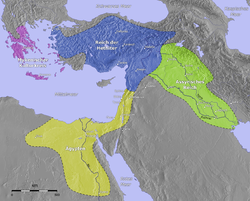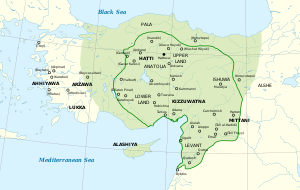இட்டைட்டு பேரரசு
இட்டைட்டு பேரரசு (Hittites) (/ˈhɪtaɪts/) வடமத்திய அனதோலியாவில், தற்கால துருக்கி, சிரியா மற்றும் லெபனான் பகுதிகளை, அட்டுசா எனும் நகரத்தை தலைமையிடமாகக் கொண்டு, கிமு 1,600 முதல் கிமு 1,178 முடிய இந்திய-ஐரோப்பிய மொழிகளில் ஒன்றான இட்டைட்டு மொழி பேசிய இட்டைட்டு மக்கள் ஆட்சி செய்தனர்.
இட்டைட்டு பேரரசு (Hittite Empire) | |||||||||
|---|---|---|---|---|---|---|---|---|---|
| கிமு 1600–கிமு 1178 | |||||||||
 கிமு 1300ல் இட்டைட்டுப் பேரரசு (நீல நிறத்தில் காட்டப்பட்டுள்ளது) | |||||||||
| தலைநகரம் | அட்டுசா | ||||||||
| பேசப்படும் மொழிகள் | இட்டைட் மொழி, லூவியான் மொழி, அக்காடியன் மொழி, அட்டிக் மொழி | ||||||||
| அரசாங்கம் | முழு முடியாட்சி(சிறு இராச்சியம்) அரசியலமைப்புக்குட்பட்ட முடியாட்சி (மத்தியகால மற்றும் புதிய இராச்சியம்)[1] | ||||||||
| பேரரசர் | |||||||||
| வரலாற்று சகாப்தம் | வெண்கலக் காலம் | ||||||||
• தொடக்கம் | கிமு 1600 | ||||||||
• முடிவு | கிமு 1178 | ||||||||
| |||||||||
| தற்போதைய பகுதிகள் | |||||||||


கிமு 14ம் நூற்றாண்டின் நடுவில், இட்டையிட்டுப் பேரரசர் முதலாம் சுப்பிலுலியுமா காலத்தில், அனதோலியா மட்டுமின்றி, வடக்கு லெவண்ட் மற்றும் மேல் மெசொப்பொத்தேமியாவைக் கைப்பற்றி ஆட்சி அதிகாரத்தில் உச்சத்தில் இருந்தது.
கிமு 15 முதல் 13ம் நூற்றாண்டு வரை, இட்டையிட்டுபேரரசு, அண்மைக் கிழக்குப் பகுதிகளில் ஆதிக்கம் செலுத்துவதற்காக, பண்டைய எகிப்து, இடைக்கால அசிரியா பேரரசு மற்றும் மிட்டன்னி (Mitanni) பேரரசுகளுடன் பிணக்குகள் கொண்டிருந்தது.
இறுதியில் அசிரியர்கள் இட்டைட்டுப் பேரரசின் பல பகுதிகளை தங்கள் இராச்சியத்துடன் இணைத்துக் கொண்டனர். இட்டைட்டு பேரரசின் எஞ்சிய பகுதிகளை, மேற்கு மத்திய அனதோலியாவின் பிரிகியா இராச்சியம் ஆக்கிரமித்துக் கொண்டது.[2]
கிமு 1180க்குப் பின்னர் வெண்கலக் காலத்தில், இட்டைட்டுப் பேரரசு உருக்குலைந்து, புதிய தன்னாட்சியுடன் கூடிய இட்டைட்டு குறுநில நகர அரசுகளாக சிதறுண்டது. இந்த குறுநில நகர இட்டைட்டு இராச்சியங்கள், கிமு 8ம் நூற்றாண்டில், புதிய அசிரியப் பேரரசால் உள்வாங்கப்படும் வரை ஆட்சி செலுத்தின.
இட்டைட்டு மொழி, இந்திய-ஐரோப்பிய மொழிகளில் ஒன்றான, அனதோலியா மொழிகளில் ஒன்றாகும்.[3]
யூதர்களின் பழைய ஏற்பாடு நூல்களில், இட்டையிட்டுகள் குறித்த செய்திகள் உள்ளது.[4]
இட்டையிட்டு ஆட்சியாளர்கள்
தொகு- பம்பா கிமு 22ம் நூற்றாண்டு
- பிதானா
- பியுஸ்தி
- அனிட்டா
- துதாலியா
- சர்ருமா
பழைய இட்டைட்டு மன்னர்கள்
தொகு| ஆட்சியாளர் | ஆட்சிக் காலம் | வம்சாவளி & முக்கிய நிகழ்வுகள் |
|---|---|---|
| லபர்னா | மரபு வழி நிறுவனர் | |
| முதலாம் ஹட்டுசிலி என்ற இரண்டாம் லபர்னா | கிமு 1586–1556 | |
| முதலாம் முர்சிலி | முதலாம் ஹட்டுசிலியின் பேரன்; கிமு 1531ல் பாப்லோனை இடித்தவர் | |
| முதலாம் ஹண்டிலி | முதலாம் முர்சிலியை கொன்றவர் | |
| முதலாம் சிதந்தா | ஹண்டிலியின் மருமகன் | |
| அம்முனா | முதலாம் சிதந்தாவின் மகன்; தனது தந்தையை கொன்றவர். | |
| முதலாம் ஹுஸ்சியா | அம்முனாவின் மகன்? | |
| தெலிபினஸ் | ஹுஸ்சியாவின் மைத்துனன்; ஹுஸ்சியாவை அரியணையிலிருந்து துரத்தியவர் |
மத்தியகால இட்டைட்டு இராச்சியம்
தொகு| ஆட்சியாளர் | ஆட்சிக் காலம் | வம்சாவளி & முக்கிய நிகழ்வுகள் |
|---|---|---|
| அல்லுவம்னா | கிமு 15ம் நூற்றாண்டு | தெலிபினுவின் மருமகன் |
| இரண்டாம் ஹண்டிலி | கிமு 1500-1450 | அல்லுவம்னாவின் மகன் |
| தஹுர்வய்லி | ||
| இரண்டாம் சிதந்தா | இரண்டாம் ஹண்டிலியின் மகன் | |
| இரண்டாம் ஹுஸ்சியா | இரண்டாம் சிதந்தாவின் மகன் | |
| முதலாம் மூவாதலி | கிமு1400 | இரண்டாம் ஹுஸ்சியாவை கொன்று நாட்டை ஆண்டவன் |
இட்டைட்டு பேரரசின் மன்னர்கள்
தொகு| ஆட்சியாளர் | ஆட்சிக் காலம் | வம்சாவளி & முக்கிய நிகழ்வுகள் |
|---|---|---|
| முதலாம் துதாலியா | கிமு 14ம் நூற்றாண்டு | மூவாதாலியை கொன்றபின் அரியணை ஏறியவர். |
| முதலாம் அர்னுவந்தா | துதாலியாவின் மருமகன் | |
| இரண்டாம் ஹட்டுசிலி (?) | ||
| இரண்டாம் துதாலியா | கிமு 1360? – 1344 | (அர்னுவந்தா அல்லது ஹட்டுசிலியின் மகன்? ) |
| இரண்டாம் துதாலியா (இளையவர்) | இரண்டாம் துதாலியாவின் மகன் | |
| முதலாம் சுப்பிலுலியுமா | கிமு 1344–1322 | இரண்டாம் துதாலியாவின் மகன்; நாட்டை விரிவாக்கினார் |
| இரண்டாம் அர்னுவந்தா | கிமு 1322–1321 | சுப்பிலுலியுமாவின் மகன் |
| இரண்டாம் முர்சிலி | கிமு 1321–1295 | முதலாம் சுப்பிலுலியுமாவின் மகன் |
| இரண்டாம் மூவாதாலி | கிமு 1295–1272 | இரண்டாம் முர்சில்யின் மகன்; 1274ல் காதேஷ் போரில் ஈடுபட்டவன் |
| மூன்றாம் முர்சிலி எனும் உர்கி-தேசுப் | கிமு 1272–1267 | இரண்டாம் மூவாதாலியின் மகன் |
| மூன்றாம் ஹட்டுசிலி | கிமு 1267–1237 | இரண்டாம் முர்சிலியின் மகன்; 1258ல் எகிப்துடன் போர் ஒப்பந்தம் மேற்கொண்டவன். |
| நான்காம் துதாலியா | கிமு 1237–1209 | மூன்றாம் ஹட்டுசிலியின் மகன்; நிக்கிரியா போர் |
| குருந்தா | கிமு 1228–1227 | இரண்டாம் மூவாதாலியின் மகன் |
| மூன்றாம் அர்னுவந்தா | கிமு 1209–1207 | நான்காம் துதாலியாவின் மகன் |
| இரண்டாம் சுப்பிலுலியுமா | கிமு 1207–1178 | நான்காம் துதாலியாவின் மகன்; கிமு 1178ல் தலைநகரம் ஹட்டுசா வீழ்ந்தது. |
இட்டைட்டு பேரரசின் தொல்பொருட்கள்
தொகுஇட்டையிட் பேரரசின் தொல்பொருட்கள் துருக்கியின் தலைநகர் அங்காராவில் உள்ள அனதோலியா நாகரீகங்களின் அருங்காட்சியகத்தில் காட்சிக்கு வைக்கப்பட்டுள்ளது.
-
சிங்கக் கோட்டை நுழைவாயில், அட்டுசா நகரம், இட்டையிட்டுப் பேரரசு
-
இட்டையிட்டு மக்களின் 12 பாதாளக் கடவுளர்கள்
-
இட்டையிட்டு பேரரசின் நினைவுச் சின்னம்
-
கிமு 1258ல் எகிப்து-இட்டையிட்டுகளின் போர் ஒப்பந்தம்
-
பிந்தைய இட்டையிட்டுக் கால மனித மற்றும் சிங்கத் தலையுடன் கூடிய சிற்பம்
-
கிமு 1235 காலத்திய வெண்கலத் தட்டு
-
மன்னர் மூவாதலியின் முத்திரை
இதனையும் காண்க
தொகுமேற்கோள்கள்
தொகு- ↑ Crime and Punishment in the Ancient World - Page 29, Israel Drapkin - 1989
- ↑ Phrygia
- ↑ "2006-05-02 Hittite". 7 July 2004. Archived from the original on 2017-02-03. பார்க்கப்பட்ட நாள் 2018-06-15.
- ↑ Biblical Hittites
வெளி இணைப்புகள்
தொகு- Video lecture at Oriental Institute – Tracking the Frontiers of the Hittite Empire பரணிடப்பட்டது 2014-04-11 at the வந்தவழி இயந்திரம்
- Hattusas/Bogazköy பரணிடப்பட்டது 2009-06-30 at the வந்தவழி இயந்திரம்
- Arzawa, to the west, throws light on Hittites
- Pictures of Boğazköy, one of a group of important sites
- Pictures of Yazılıkaya, one of a group of important sites
- Der Anitta Text (at TITUS)
- Tahsin Ozguc
- Hittites.info
- Hittite Period in Anatolia
- Hethitologieportal Mainz, by the Akademie der Wissenschaften, Mainz, corpus of texts and extensive bibliographies on all things Hittite
- hittites area in cappadocia பரணிடப்பட்டது 2013-05-21 at the வந்தவழி இயந்திரம்
- Uşaklı Höyük
இலக்கியங்களில்
தொகு- Akurgal, Ekrem (2001) The Hattian and Hittite Civilizations, Publications of the Republic of Turkey, Ministry of Culture, பன்னாட்டுத் தரப்புத்தக எண் 975-17-2756-1
- Anthony, David W. (2007), The Horse, the Wheel and Language. How Bronze-Age Riders from the Eurasian Steppes Shaped the Modern World, Princeton University Press
{{citation}}: Invalid|ref=harv(help) - Bryce, Trevor R. (1998). The Kingdom of the Hittites. Oxford. (Also: 2005 hard and softcover editions with much new material)
- Bryce, Trevor R. (2002) Life and Society in the Hittite World, Oxford.
- Ceram, C. W. (2001) The Secret of the Hittites: The Discovery of an Ancient Empire. Phoenix Press, பன்னாட்டுத் தரப்புத்தக எண் 1-84212-295-9.
- Forlanini, Massimo (2010). "An Attempt at Reconstructing the Branches of the Hittite Royal Family of the Early Kingdom Period". In Cohen, Yoram; Gilan, Amir; Miller, Jared L. (eds.). Pax Hethitica: Studies on the Hittites and Their Neighbours in Honour of Itamar Singer. Otto Harrassowitz Verlag.
{{cite book}}: Invalid|ref=harv(help) - Gurney, O.R. (1952) The Hittites, Penguin, பன்னாட்டுத் தரப்புத்தக எண் 0-14-020259-5
- Güterbock, Hans Gustav (1983) "Hittite Historiography: A Survey," in H. Tadmor and M. Weinfeld eds. History, Historiography and Interpretation: Studies in Biblical and Cuneiform Literatures, Magnes Press, Hebrew University pp. 21–35.
- Hoffner, Jr., H.A (1973) "The Hittites and Hurrians," in D. J. Wiseman Peoples of the Old Testament Times, Clarendon Press, Oxford.
- Jasanoff, Jay H. (2003). Hittite and the Indo-European Verb. Oxford: Oxford University Press. பன்னாட்டுத் தரப்புத்தக எண் 0-19-924905-9.
{{cite book}}: Invalid|ref=harv(help) - Kloekhorst, Alwin (2007), Etymological Dictionary of the Hittite Inherited Lexicon, பன்னாட்டுத் தரப்புத்தக எண் 978-90-04-16092-7
- Macqueen, J. G. (1986) The Hittites, and Their Contemporaries in Asia Minor, revised and enlarged, Ancient Peoples and Places series (ed. G. Daniel), Thames and Hudson, பன்னாட்டுத் தரப்புத்தக எண் 0-500-02108-2.
- Mallory, J.P.; Adams, D.Q. (1997), Encyclopedia of Indo-European Culture, Taylor & Francis
{{citation}}: Invalid|ref=harv(help) - Melchert, H. Craig (2012). "The Position of Anatolian" (PDF).
{{cite web}}: Invalid|ref=harv(help) - Mendenhall, George E. (1973) The Tenth Generation: The Origins of the Biblical Tradition, The Johns Hopkins University Press, பன்னாட்டுத் தரப்புத்தக எண் 0-8018-1654-8.
- Neu, Erich (1974) Der Anitta Text, (StBoT 18), Otto Harrassowitz, Wiesbaden.
- Orlin, Louis L. (1970) Assyrian Colonies in Cappadocia, Mouton, The Hague.
- Parpola, Asko (2015), The Roots of Hinduism. The Early Aryans and the Indus Civilization, Oxford University Press
- Patri, Sylvain (2007), L'alignement syntaxique dans les langues indo-européennes d'Anatolie, (StBoT 49), Otto Harrassowitz, Wiesbaden, பன்னாட்டுத் தரப்புத்தக எண் 978-3-447-05612-0
மேலும் படிக்க
தொகு- Jacques Freu et Michel Mazoyer, Des origines à la fin de l'ancien royaume hittite, Les Hittites et leur histoire Tome 1, Collection Kubaba, L'Harmattan, Paris, 2007 ;
- Jacques Freu et Michel Mazoyer, Les débuts du nouvel empire hittite, Les Hittites et leur histoire Tome 2, Collection Kubaba, L'Harmattan, Paris, 2007 ;
- Jacques Freu et Michel Mazoyer, L'apogée du nouvel empire hittite, Les Hittites et leur histoire Tome 3, Collection Kubaba, L'Harmattan, Paris, 2008.
- Jacques Freu et Michel Mazoyer, Le déclin et la chute de l'empire Hittite, Les Hittites et leur histoire Tome 4, Collection Kubaba, L'Harmattan, Paris 2010.
- Jacques Freu et Michel Mazoyer, Les royaumes Néo-Hittites, Les Hittites et leur histoire Tome 5, Collection Kubaba, L'Harmattan, Paris 2012.